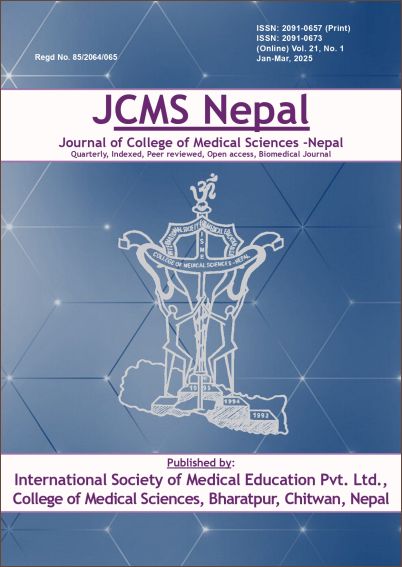Comparative Study of Supine Versus Prone Percutaneous Nephrolithotomy
DOI:
https://doi.org/10.3126/jcmsn.v21i1.72574Keywords:
PCNL, supine position, prone position, operative time, stone free rate, sight threatening complicationsAbstract
Background
Percutaneous nephrolithotomy (PCNL) performed in the prone position is known for its high success rate and low morbidity. However, the supine position offers notable advantages, leading to a debate over the preferred position for PCNL. This study aimed to compare the efficacy and safety profiles of PCNL to determine if one position is superior to the other.
Methods
A prospective comparative study was conducted in Kathmandu Medical College and Teaching Hospital, Kathmandu, involving 60 patients over a six months period from January, 2024 to July, 2024, who underwent PCNL. All patients were divided into 2 groups, in which group 1 underwent PCNL in supine position and group 2 underwent PCNL in prone position. We have evaluated the two approaches in terms of operative time, stone clearance rate, drop in hemoglobin, hospital stay and complications.
Results
The stone free rate was slightly higher in supine group (86%) compared to the prone group (82%), though this difference was not statistically significant (p-value 0.12). Mean operative time was significantly shorter for supine PCNL (74.63±12.42 min) than prone PCNL (90.02±12.67 min) (p-value <0.0001). Overall complication rates were 15% in supine group and 25% in prone group, with no statistically significant difference (p-value = 0.51). Patients in the prone PCNL group had a significantly longer hospital stay (3.20±0.92 days) compared to the supine group (2.40±0.74 days) (p-value <0.001).
Conclusions
Supine PCNL is as effective and safe as prone PCNL, while having significantly shorter operative time.
Downloads
Downloads
Published
How to Cite
Issue
Section
License
Copyright (c) 2025 The Author(s)

This work is licensed under a Creative Commons Attribution-NonCommercial-NoDerivatives 4.0 International License.
This license enables reusers to copy and distribute the material in any medium or format in unadapted form only, for noncommercial purposes only, and only so long as attribution is given to the creator.




